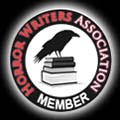Today is the day, the announcement of the 2023 Summer Scares Spokesperson. You can click here to access the Summer Scares Resource page to read the full press release.
It's New York Times bestselling author Daniel Kraus!
Kraus is not new to Summer Scares. Rotters was one of our inaugural YA picks back in 2019, and he has filled in whenever we needed an extra author every year since. And, he is also a librarian and former editor at our sponsor, Booklist.
But this year, we are especially excited to have Kraus officially on board for 2 main reasons.
- Kraus is a Guest of Honor at StokerCon 2023 in Pittsburgh this coming June. We are excited to celebrate him doubly at the event.
- And this is KEY, Kraus writes Horror for every age level. We wanted an author who represented the adults, teens, and middle grade readers we are seeking, and I would argue that no one else in the Horror world has proven that he can scare readers at every age as well as Kraus can.
Being named the 2023 Summer Scares spokesperson feels like coming home.
It also feels like a call to arms.
The small Iowa town where I grew up only had one modest library, but it was the stuff horror dreams (and maybe a few outright nightmares?) were made of. Built in 1893, the Jefferson County Library was the first Carnegie Library west of the Mississippi. Though no longer used as a library, it still stands today—and is every bit as spooky. Stern red brick. High vertical windows. An archway over the entryway featuring a jade-eyed owl. It’s both handsome and slightly reminiscent of a nineteenth-century lunatic asylum.
[If you want an image: http://www.fairfieldculturaldistrict.org/heritage/Library/siteindex.htm]
Inside, it only got spookier. Old portraits with glaring eyes. Blank-faced statues. Two small floors of stacks, which grew dark near the back. A giant, outright terrifying bison head hanging over a stairway leading to a dimly lit top-floor museum. Inside were everything from shark jaws to taxidermized animals that had started to rot through their fur.
I got scared a lot at that library. And I wouldn’t have it any other way.
[If you want spooky images of the library in the 1890s: http://www.fairfieldculturaldistrict.org/heritage/Library/tour.htm]
If I were transported back in that library circa 1987, I could take you directly to the Stephen King section. To the paperback spinner rack where I first came upon Clive Barker’s Books of Blood. To the shelf with the bound copies of old Mad Magazines, which, for reasons I can’t articulate, scared me senseless. To the corner of the kid’s section featuring nonfiction titles on ghosts, hauntings, and the paranormal. To the LPs. Oh, lord, the LPs. How many times did I go into my basement, turn out the lights, and lose my young mind over haunted vinyl like Sounds to Make You Shiver!, House of Terror, and A Story of Dracula, the Wolfman, and Frankenstein, which I can still quote from verbatim.
The library was filled with frights. But unlike the threats and insecurities of school bullies, creepy adults, and the half-understood scourges of poverty, mental illness, and abuse all around me—all around everyone, no matter what town you lived in—the library’s frights could be controlled.
I could dial up the horror whenever I wanted: Harvest Home by Thomas Tryon, its spooky dust jacket a taunting dare. Or I could dial it back down: Watership Down, a book about rabbits for crying out loud, but recommended via King’s Danse Macabre—and a lot more harrowing than I expected. (I read a large-print edition, by the way, the only copy the library had.) It all worked its dark magic.
Horror didn’t just change my life. It saved it.
In the 1980s, the pervading idea was that children and teens who were into horror were, at best, budding perverts and sickos, and at worst, up-and-coming satanic cultists. This notion wasn’t helped by the flourishing of VHS rental businesses that relegated the horror section to the scuzziest back corner, equating it with the Adult section behind the curtain. Grimy, grindhouse-era box cover art seemed to revel in it with such infamous box covers as Faces of Death and Fulci’s Zombie. Horror in that era conjured up images of 42nd Street New York cinemas—drug-addicted sleazoids getting murdered by black-gloved knife-wielders. In a cruddy dumpster inside a seedy Manhattan alley—that was where your kid’s body would be found if you let them continue down horror’s grim path.
My choice of genres, in other words, wasn’t the popular choice, nor the choice promoted by most adults and parents. My mom was an exception; I’ve written about her influence dozens of times. Who I ought to celebrate more, however, were my librarians.
Did the books I checked out at the library upset me? Often they did. But that was, and is, the value of horror to me: the testing the limits. As a kid, that meant finding out what scared me, retreating a bit, analyzing my reaction, and then returning to the scene of the crime and borrowing that book again, or renting that movie again, to see if I’d mastered my reaction over it.
A horror fan might run away—but they always come back.
Many people lose this adventurous spirit as they get older. Not horror readers, and certainly not horror writers. We are always pressing, always probing, always seeing how far we are willing to go. This doesn’t make us lesser citizens of the world. It makes us better citizens of the world.
Time and again, you’ll hear the old chestnut from those who have met a horror artist and said with astonishment: “I couldn’t believe how nice they were!” That is correct. Horror writers and readers are empathy experts. We understand the commonality of fear. And it is fear—and fear’s sister emotion, hope—that drives us, at a societal and biologic level, toward every major decision of our lives. This is how, piece by piece, culture evolves.
Where do the most important societal changes come from? The fringes. What is the genre most identified with fringes? Horror. Along with romance/erotica, I would argue, horror is the genre that operates on deepest of gut levels. It is the bellwether, the harbinger. It the genre that not only dares to be transgressive, but has transgression imprinted into its very DNA.
The same things that make horror the genre that understands fear is what makes horror the genre that welcomes one and all. Because in the dead of night, when our lives are threatened, when the blood and adrenaline are pumping, there are no divisions between us. We realize that we are all part of the same family.
And who are the midwives of that family? Who are the hosts that bring so many of us together, to celebrate what scares us, thereby celebrating what we have in common? Librarians. I am endlessly grateful to the librarians who had confidence that I, and millions of others, could navigate our boundaries as readers. The librarians working today are doing that same work, fighting to help readers find themselves as children, teens, or adults, and doing so under increasingly hostile conditions. We must support them in every way we can.
It’s only fair. They supported us first.






